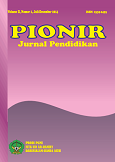MENINGKATKAN HASIL BELAJAR BAHASA INGGRIS SISWA DIMASA NEW NORMAL MELALUI E-MODUL INTERAKTIF
DOI:
https://doi.org/10.22373/pjp.v10i2.10299Keywords:
Interactive E-Module, Learning Outcomes, New NormalAbstract
The low learning outcomes of students during the new normal period are generally influenced by school shifts and shortened study times. This study aims to improve the Students English learning outcomes of class VII A in MTsN 4 East Aceh in the new normal period through the Interactive E-module for the 2020/2021 Academic Year. This type of research is a Classroom Action Research which is conducted in two cycles. The research subjects were 30 grade students of class VII A MTsN 4 Aceh Timur. The data collection techniques used were observation, tests, questionnaires and documentation. The data analysis technique used is descriptive quantitative. The results of this study indicate that the use of the Interactive E-Module Media can improve the English learning outcomes of class VII A students of MTsN 4 Aceh Timur. The percentage of student learning outcomes increased, it can be seen from the test results in cycle I 70% to 86,67% in cycle II.
References
Abdullah Sani. Ridwan dan Sudiran. (2016). Penelitian TIndakan Kelas Pengembangan Profesi Guru. Tangerang: Tsmart
Asyhar, R. (2012). Kreatif Mengembangkan Media Pembelajaran. Jakarta: Gaung Persada (GP) Press Jakarta.
Depdiknas. (2006). Bunga Rampai Keberhasilan Guru dalam Pembelajaran (SMA, SMK, dan SLB). Jakarta: Depdiknas.
Duniapcoid. (2020). Jenis Media Interaktif. https://duniapendidikan.co.id/media-interaktif/
Hamalik, O. ( 2006). Proses Belajar Mengajar. Jakarta: PT Bumi Aksara
Imansari, N., & Sunaryantiningsih, I. (2017). Pengaruh Penggunaan E-modul interaktifTerhadap Hasil Belajar Mahasiswa pada Materi Kesehatan dan Keselamatan Kerja. VOLT : Jurnal Ilmiah Pendidikan Teknik Elektro, 2(1), 11. https://doi.org/10.30870/volt.v2i1.1478
Nurmayanti, F. (2015). Pengembangan Modul Elektronik Fisika dengan Strategi PDEODE pada Pokok Bahasan Teori Kinetik Gas untuk Siswa Kelas XI SMA. Prosiding Simposium Nasional Inovasi dan Pembelajaran Sains. Bandung: ITB.
Prastowo, A. (2015). Panduan Kreatif Membuat Bahan Ajar Inovatif. Jogjakarta: DIVA Press.
Raharjo, W.C., Suryati, & Khery, Y. (2017). Pengembangan e-modul nteraktif menggunakan adobe flash pada materi ikatan kimia untuk mendorong literasi sains siswa. Jurnal Ilmiah Pendidikan Kimia Hydrogen, 5 (1), 8-13. https://doi.org/10.33394/hjkk.v5i1.102
Ricu Sidiq, & Najuah. (2020). Pengembangan E-modul interaktifBerbasis Android pada Mata Kuliah Strategi Belajar Mengajar. Jurnal Pendidikan Sejarah, 9(1), 1–14. https://doi.org/10.21009/jps.091.01.
Rita, J. (2014). Pengembangan pembelajaran Multimedia interaktif berbasis internet pelajaran Bahasa inggris. Jurnal Teknologi Informasi & Komunikasi dalam Pendidikan, 1 (2), 2355-4983.
Sudjana, N. ( 2010). Penilaian Hasil Proses Belajar Mengajar. (Cet. XV). Bandung: PT. Ramaja Rosdakarya.
Wiyoko, T. (2014). Pengembangan Media Pembelajaran Fisika Modul Elektronik Animasi Interaktif untuk Kelas XI SMA ditinjau dari Motivasi Belajar Siswa. Pendidikan Fisika.
Downloads
Published
Issue
Section
License
- Authors retain copyright and grant the journal right of first publication with the work simultaneously licensed under a Creative Commons Attribution License that allows others to share the work with an acknowledgment of the work's authorship and initial publication in this journal.
- Authors are able to enter into separate, additional contractual arrangements for the non-exclusive distribution of the journal's published version of the work (e.g., post it to an institutional repository or publish it in a book), with an acknowledgment of its initial publication in this journal.
- Authors are permitted and encouraged to post their work online (e.g., in institutional repositories or on their website) prior to and during the submission process, as it can lead to productive exchanges, as well as earlier and greater citation of published work (See The Effect of Open Access).

